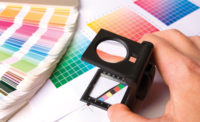Without a doubt, one of the most important components of plate-mounting tapes is the adhesive system. The efficiency and process repeatability of mounting and demounting flexographic printing plates can be largely correlated to the behavior of the adhesive system on the tape and its ease of use during the printing plate management process. The adhesive can be the distinguishing factor between having to clean adhesive particles and foam residue from every cylinder when the job is stripped or, conversely, having clean removal of the tape from the plate with little to no cleaning required.
The adhesive requirements are simple: bond to the sleeves/cylinders and plates as securely as possible during the printing process to completely eliminate any possibility of plate edge lifting or bubbling, and when the job is done, remove as easily as a siliconized liner. This ideal, however, has been difficult for many printers to realize. On a daily basis, most printers contend with printing plate edge lifting because of the use of thicker plates on narrow diameter cylinders or damaged printing plates because the adhesion to the plate is so high that they either stretch or tear during the demounting process.
To overcome edge lifting, printers have used primers, magic markers, edge sealers and tapes. Additionally, many printers have used adhesion blockers – such as talc, chalk, soap or shellac – to make removal easy enough so as not to destroy the plates. All of these techniques, however, make it extremely difficult to create an SOP (standard operating procedure) that is efficient and repeatable. In fact, with so many materials and variables in such a process, repeatability is virtually impossible.
When process replication and repeatability is unachievable, process efficiency is impossible. When selecting a plate-mounting tape, be sure to select one that has a plate-side adhesive that is made for the plate material and thickness being used. If an incorrect tape is selected, prevalent edge lifting can occur with thicker plates or torn or stretched plates with thin plates. Additionally, be sure to choose an adhesive that is designed to bond to the cylinder or sleeves material being used. Using the wrong open-side adhesive can mean either bubbling or labor-intensive cleanup.
Regardless of the type of adhesive that best fits a particular process, the proper SOP detailed below will help maximize plate return on investment (ROI) and simplify the process:
Plate & Cylinder Cleaning
All components must be at the same room temperature to lessen the effects of expansion and contraction due to heat or cold between mounting and running.
Both new and used plates must be cleaned to remove all dust, grease or other contamination using 100 percent clean IPA and a paper towel. Even if a plate is new, there are still chemical residues on the plate that can block proper adhesion.
Clean the sleeve or cylinder according to the specific manufacturer’s guidelines and ensure the surface is completely dry prior to mounting.
Plate Mounting
When applying the tape to the sleeve/cylinder, apply it with a complete side-to-side sweeping motion to ensure that the tape is securely and evenly fastened. A soft squeegee can help apply the most pressure.
When mounting the plate, use the liner to expose a narrow area of tape. Initially adhere the plate only to the narrow area to make repositioning easier.
Use a soft rubber roller to apply pressure on the plate to the tape. This will ensure maximum bonding of the plate to the tape, diminishing the chance for edge lifting.
Demounting
Remove the plate from the tape first.
After the plate is removed, slowly remove the tape from the sleeve/cylinder at a low, flat angle.
By following these simple steps in your plate-mounting SOP, you can save numerous hours of downtime and thousands of dollars in unnecessary materials and plate damage, ultimately improving the process ROI.
tesa tape, inc.
www.tesatape.com





